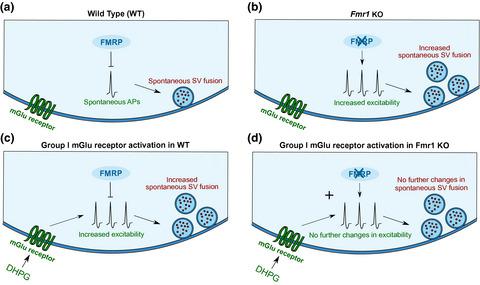当前位置:
X-MOL 学术
›
J. Neurochem.
›
论文详情
Our official English website, www.x-mol.net, welcomes your
feedback! (Note: you will need to create a separate account there.)
Reciprocal regulation of spontaneous synaptic vesicle fusion by Fragile X mental retardation protein and group I metabotropic glutamate receptors
Journal of Neurochemistry ( IF 4.2 ) Pub Date : 2021-07-29 , DOI: 10.1111/jnc.15484 Rohini Subrahmanyam 1 , Deepanjali Dwivedi 1 , Zubin Rashid 1 , Katherine Bonnycastle 2, 3, 4 , Michael A Cousin 2, 3, 4 , Sumantra Chattarji 1, 2, 3, 4, 5
Journal of Neurochemistry ( IF 4.2 ) Pub Date : 2021-07-29 , DOI: 10.1111/jnc.15484 Rohini Subrahmanyam 1 , Deepanjali Dwivedi 1 , Zubin Rashid 1 , Katherine Bonnycastle 2, 3, 4 , Michael A Cousin 2, 3, 4 , Sumantra Chattarji 1, 2, 3, 4, 5
Affiliation

|
Fragile X mental retardation protein (FMRP) is a neuronal protein mediating multiple functions, with its absence resulting in one of the most common monogenic causes of autism, Fragile X syndrome (FXS). Analyses of FXS pathophysiology have identified a range of aberrations in synaptic signaling pathways and plasticity associated with group I metabotropic glutamate (mGlu) receptors. These studies, however, have mostly focused on the post-synaptic functions of FMRP and mGlu receptor activation, and relatively little is known about their presynaptic effects. Neurotransmitter release is mediated via multiple forms of synaptic vesicle (SV) fusion, each of which contributes to specific neuronal functions. The impacts of mGlu receptor activation and loss of FMRP on these SV fusion events remain unexplored. Here we combined electrophysiological and fluorescence imaging analyses on primary hippocampal cultures prepared from an Fmr1 knockout (KO) rat model. Compared to wild-type (WT) hippocampal neurons, KO neurons displayed an increase in the frequency of spontaneous excitatory post-synaptic currents (sEPSCs), as well as spontaneous SV fusion events. Pharmacological activation of mGlu receptors in WT neurons caused a similar increase in spontaneous SV fusion and sEPSC frequency. Notably, this increase in SV fusion was not observed when spontaneous activity was blocked using the sodium channel antagonist tetrodotoxin. Importantly, the effect of mGlu receptor activation on spontaneous SV fusion was occluded in Fmr1 KO neurons. Together, our results reveal that FMRP represses spontaneous presynaptic SV fusion, whereas mGlu receptor activation increases this event. This reciprocal control appears to be mediated via their regulation of intrinsic neuronal excitability.
中文翻译:

脆性 X 智力低下蛋白和 I 型代谢型谷氨酸受体对自发突触囊泡融合的相互调节
脆性 X 型智力低下蛋白 (FMRP) 是一种神经元蛋白,可调节多种功能,其缺失会导致自闭症最常见的单基因病因之一,即脆性 X 综合征 (FXS)。FXS 病理生理学分析已经确定了一系列与 I 组代谢型谷氨酸 (mGlu) 受体相关的突触信号通路和可塑性的畸变。然而,这些研究主要集中在 FMRP 和 mGlu 受体激活的突触后功能上,对它们的突触前作用知之甚少。神经递质释放是通过多种形式的突触小泡 (SV) 融合介导的,每种形式都有助于特定的神经元功能。mGlu 受体激活和 FMRP 丢失对这些 SV 融合事件的影响仍未探索。Fmr1敲除 (KO) 大鼠模型。与野生型 (WT) 海马神经元相比,KO 神经元显示自发兴奋性突触后电流 (sEPSC) 以及自发 SV 融合事件的频率增加。WT 神经元中 mGlu 受体的药理学激活导致自发 SV 融合和 sEPSC 频率的类似增加。值得注意的是,当使用钠通道拮抗剂河豚毒素阻断自发活动时,未观察到这种 SV 融合的增加。重要的是,mGlu 受体激活对自发 SV 融合的影响在Fmr1 中被封闭KO神经元。总之,我们的结果表明 FMRP 抑制自发性突触前 SV 融合,而 mGlu 受体激活增加了这一事件。这种相互控制似乎是通过它们对内在神经元兴奋性的调节来介导的。
更新日期:2021-08-26
中文翻译:

脆性 X 智力低下蛋白和 I 型代谢型谷氨酸受体对自发突触囊泡融合的相互调节
脆性 X 型智力低下蛋白 (FMRP) 是一种神经元蛋白,可调节多种功能,其缺失会导致自闭症最常见的单基因病因之一,即脆性 X 综合征 (FXS)。FXS 病理生理学分析已经确定了一系列与 I 组代谢型谷氨酸 (mGlu) 受体相关的突触信号通路和可塑性的畸变。然而,这些研究主要集中在 FMRP 和 mGlu 受体激活的突触后功能上,对它们的突触前作用知之甚少。神经递质释放是通过多种形式的突触小泡 (SV) 融合介导的,每种形式都有助于特定的神经元功能。mGlu 受体激活和 FMRP 丢失对这些 SV 融合事件的影响仍未探索。Fmr1敲除 (KO) 大鼠模型。与野生型 (WT) 海马神经元相比,KO 神经元显示自发兴奋性突触后电流 (sEPSC) 以及自发 SV 融合事件的频率增加。WT 神经元中 mGlu 受体的药理学激活导致自发 SV 融合和 sEPSC 频率的类似增加。值得注意的是,当使用钠通道拮抗剂河豚毒素阻断自发活动时,未观察到这种 SV 融合的增加。重要的是,mGlu 受体激活对自发 SV 融合的影响在Fmr1 中被封闭KO神经元。总之,我们的结果表明 FMRP 抑制自发性突触前 SV 融合,而 mGlu 受体激活增加了这一事件。这种相互控制似乎是通过它们对内在神经元兴奋性的调节来介导的。











































 京公网安备 11010802027423号
京公网安备 11010802027423号